Harrison McIntosh (Born 1914 – Died 2016) was a ceramic artist from the United States. He was best known for his Mid-Century Modern pottery style, which featured simple symmetrical forms. Japanese pottery and aesthetics, as well as European modern design, influence his art. McIntosh was particularly renown for decorating his pots with thin lines using a sgraffito technique.
| Artist | Harrison Edward McIntosh |
| Born | September 11, 1914, Vallejo, CA. Vallejo is a waterfront city in Solano County, California, located in the North Bay subregion of the San Francisco Bay Area. |
| Died | January 21, 2016 (aged 101) Claremont, California, U.S. Claremont is a suburban city on the eastern edge of Los Angeles County, California, United States, 30 miles (48 km) east of downtown Los Angeles. |
| Education | Claremont Graduate School. The Claremont Graduate University (CGU) is a private, all-graduate research university in Claremont, California. |
| Art Style | Mid-Century Modern pottery style featuring simple symmetrical forms. |
| Nationality | American |
Harrison McIntosh Education

He went to the 1939 World’s Fair in San Francisco, where he witnessed his first exhibition of hand-thrown pottery, which took place in the Japanese Pavilion. This encounter motivated him to enroll in mediumship classes with Glen Lukens at the University of Southern California as a result of the event.
Upon completion of a few classes, McIntosh began working on a turning wheel intended for carving cast works in his workshop, where he would frequently experiment with thick glazes. He often sold these early experimental sculptures for a few hundred dollars. Mary Stanfield, a fellow artist, and McIntosh were married in 1942.
The following year, he, his brother, and ceramicist Albert Henry King collaborated on the creation of The Californians, a tiny exhibition space on Sunset Boulevard. However, because of the United States’ engagement in World War II, his ambitions came to a grinding halt, and he was drafted into the army and stationed in Northern California as a doctor. When McIntosh’s wife got dangerously ill at this time, he was released from the hospital to care for her. Stanfield died in his wife’s arms after six years of marriage.
In 1948, McIntosh used the GI Bill to enroll in the Claremont Graduate School’s MFA program in ceramics, which was directed by Millard Sheets and was funded by the Veterans Administration. While in San Diego, he studied ceramics under Richard Petterson at Scripps College, and he also took part in workshops with Bernard Leach at Mills College, with Japanese ceramicist Shiji Hamada while on tour in the United States, and with Marguerite Wildenhain at Pond Farm during the summer of 1953, among other things.
McIntosh met his second wife, Marguerite Loyau, in one of Petterson’s classes at Scripps College, where they were both students. Loyau was in the United States on a Fulbright Fellowship through the Teacher Exchange Program, and he was teaching French at Pomona College while in the country. They tied the knot in 1952 and welcomed their daughter, Catherine McIntosh, into the world two years later. Eventually, Marguerite took over as her husband’s business manager, frequently cooperating with him on creative projects and putting on exhibitions of his artwork.
At CGU, McIntosh formed acquainted with fellow student and ceramicist Rupert Deese, with whom he co-founded an art studio on Foothill Boulevard in Claremont, California, which is still in operation today. For the next 50 years, McIntosh and Deese worked together as business partners and friends, first at the Foothill Boulevard facility from 1950 to 1958, and then in a studio at Padua Hills until 2006. McIntosh and Deese were married in 1956.
In addition to his long-standing friendship with Deese, McIntosh maintained close ties with several prominent Claremont artists, including Jim Hueter, Karl Benjamin, and Sam Maloof, among others.
Harrison McIntosh Early Career
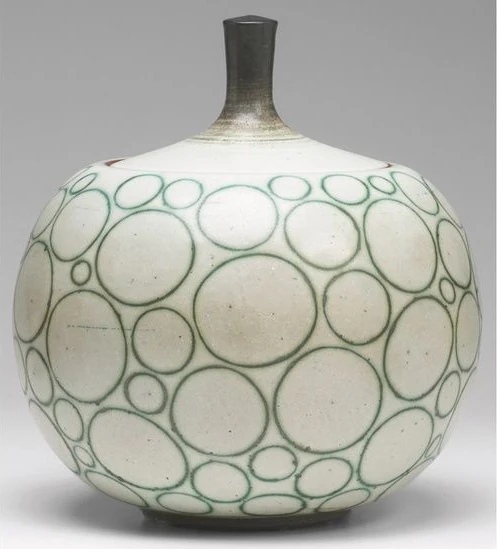
Harrison Edward McIntosh (11 September 1914–21 January 2016) was an American ceramic artist who worked in the medium of ceramics and glass. He was a ceramicist who worked in the Mid-Century Modern style, which was characterized by basic symmetrical forms. His art has been displayed in galleries and museums around the United States, including the Smithsonian Institution, as well as overseas, including the Louvre in Paris.
McIntosh was born in Vallejo, California, to Harrison McIntosh, a ragtime piano player, and Jesusita (née Coronado) McIntosh. His father was a jazz musician and his mother was a singer.
McIntosh was up in Stockton, California, where his father worked as a sales representative for Sperry Flour. McIntosh’s interest in the arts and architecture was sparked by the construction of the Haggin Museum, which was being built by the city of Stockton at the time.
When McIntosh was in high school, he and his younger brother, Robert, enrolled in informal painting sessions with artist Arthur Haddock. After high school, both Robert and Harrison McIntosh pursued careers in the arts; Robert as a painter and Harrison as a sculptor.
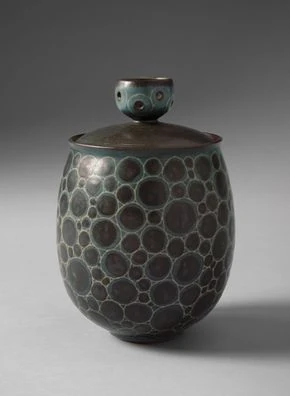
Two years after graduating from high school in 1933, McIntosh worked as a camp artist at a Civilian Conservation Corps camp in Yosemite, while his brother Robert was awarded a scholarship to attend Art Center School, which is now known as Art Centre College of Design in Pasadena, California. In 1937, after nearly two years as a camp artist with the Civilian Conservation Corps, McIntosh relocated to Los Angeles and studied art for six months at the Art Center College of Design.
McIntosh began working at the Foundation of Western Art in 1938, where he would spend his mornings as a gallery attendant and assistance to the directors of the institution. Also, he would work on commissions for Gustav Gilbert, proprietor of the art materials business The Louvre, creating hand-carved picture frames for his company’s display cases and windows.
Harrison’s parents decided to employ architect Richard Neutra to design and build their new home on Harrison’s recommendation. McIntosh assisted Neutra with the design and construction of the garage, and in the process, he learned about architectural principles and was able to include a workshop in the structure. Many prominent California painters of the time, such Millard Sheets, as well as influential early ceramicists such as Gertrud and Otto Natzler, were discovered during McIntosh’s formative years in the state of California.
Harrison McIntosh Career
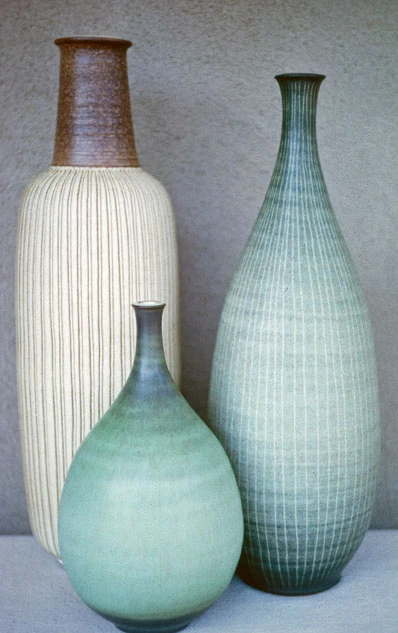
Teaching at the Los Angeles Country Art Institute (now known as Otis College of Art and Design) for various periods between 1956 and 1959 allowed McIntosh to become acquainted with colleague teacher Peter Voulkos, whom he later married. This is where he met artists Paul Soldner, John Mason, and Kenneth Price who, together with Voulkos, was attempting to translate the nascent Abstract Expressionist style into their ceramic work.
Despite his admiration for their work, McIntosh found himself dissatisfied with the direction in which he was going: “I was more interested in working with a medium I enjoyed and creating things that other people enjoyed.” He immediately left his teaching post in order to devote his full attention to his studio activity.
During the first two decades of his professional life, McIntosh sold his work in a variety of home-furnishing establishments, including Bullocks Wilshire, Van Kepple Green in Beverly Hills, Kurt Wagner’s in Redondo Beach, and Abacus in Pasadena, among others.

He accepted a variety of mass manufacturing jobs throughout his career, despite the fact that he preferred to work from home at his studio. From 1955 to 1956, McIntosh worked as an employee at Metlox Manufacturing Company, where he designed giftware prototypes, and from 1964 to 1966, he worked as an employee at Interpace International Pipe and Ceramics Corporation, where he designed tiles.
During the summers of 1970 to 1980, McIntosh and his wife traveled to Japan to collaborate on tableware and glassware lines for Mikasa, a Japanese porcelain company. After that, he was represented by the Louis Newman Galleries in Beverly Hills for the rest of the 1980s, where he had a solo show virtually every year until the gallery closed its doors in 1992. In the 1990s, he was represented by the Frank Lloyd Gallery, which is located in Santa Monica.
McIntosh was diagnosed with glaucoma and macular degeneration in 1992; yet, the ceramicist continued to work in his workshop until 2006 when he was 91 years old. McIntosh died on January 21, 2016, at the age of 101, after a long illness.
McIntosh has had 43 solo exhibitions during the course of his more than 60-year career. He is recognized in more than 40 art collections throughout the world (The Evolution Of Art And How It Shaped The Modern World).
Harrison McIntosh Style
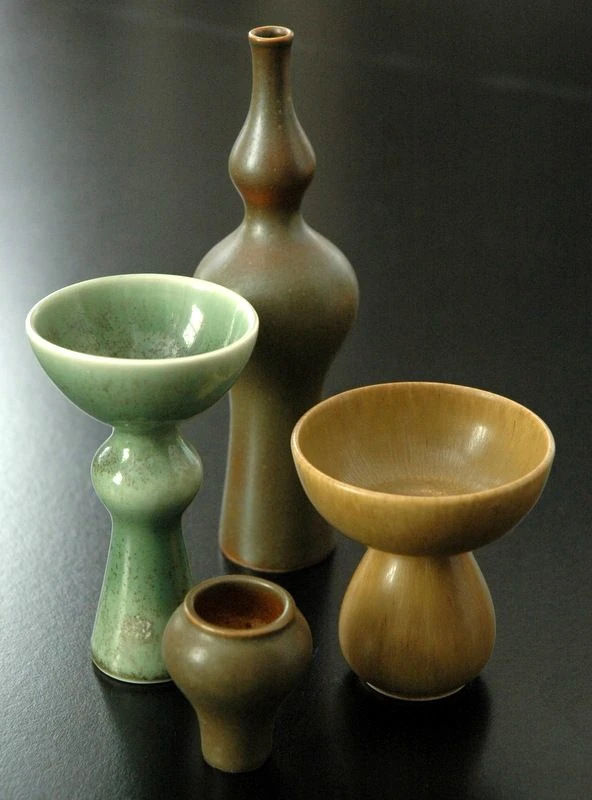
Throughout his career, McIntosh maintained a constant style that was inspired by Japanese pottery and aesthetics, as well as European modern design and architecture.
The modern, functional forms of vessels allowed McIntosh to express subtlety and deliberation in contrast to many of his colleagues who were known for creating big emotional works connected with Abstract Expressionism.
“I can definitely discern a style influenced by Japanese ceramics and aesthetics, as well as European modern design and architecture. I like how he decorates his pots with tiny lines created with a sgraffito “scratched” method.”
Ed Shears
“Thin sgraffito lines or rhythmic brush spots,” as McIntosh described them, were created by applying contrasting slip to the surface of his pots with Japanese brushes and sponges and then firing the pots. A method he frequently used was the Mishima technique, which is a procedure in which the engobe is stroked into thin incised lines in a work of art.
The quality of these brushstrokes and lines, on the other hand, altered during the course of his artistic career. When it comes to decorating, while McIntosh’s early works are regular and rhythmic in their appearance, his later works became more dynamic as he experimented with line-work that portrayed movement.
Abstract Ceramic Sculptures
McIntosh has acknowledged a fascination with ceramic objects that look to be weightless, as if they were floating in space, throughout his career. In order to achieve this impression, his early vases were frequently balanced on a small trimmed foot.
In 1968, McIntosh began experimenting with abstract sculptural shapes, the first of which, Blue Egg, was shown in the touring exhibition Objects: the USA in 1969. McIntosh’s work has been exhibited internationally since then. It was in this vein that he created his first abstract works: conical shapes without a foundation that appeared to float over wooden bases, which were an extension of his vessel form.
As he continued to work on these sculptural sculptures, he began to incorporate chrome-plated steel into his pieces, using it as bases and angled planes, among other things. The positioning of these steel walls results in a mirrored surface that emphasizes the appearance of the ceramic form being suspended in space, similar to how planets appear to be suspended in space. In later works, McIntosh refined and expanded on these concepts in subtle ways; for example, he moved away from ovoid forms and began employing more complicated shapes while still referencing cosmic themes.
Harrison McIntosh Exhibitions

- 1950-1968 Everson Museum, Syracuse, NY Ceramic National Exhibition
- 1953-1971 Pasadena Museum of California Art, Pasadena, CA California Design
- 1953-1971 University of Illinois, Urbana, IL American Craftsman
- 1955 Cannes, France First International Ceramic Festival
- 1955-1969 Scripps College, Claremont, CA Ceramic Annual
- 1956 Museum of Contemporary Crafts, New York, NY Craftsmanship in a Changing World
- 1958 Los Angeles County Museum of Art, Los Angeles, CA Craftsmanship
- 1959 Ostend, Belgium Second International Ceramic Festival
- 1964-1965 Philadelphia Museum College of Art, Philadelphia, PA Craftsmanship Defined, 12 American Craftsmen
- 1969 The Johnson Collection of Contemporary Crafts, Smithsonian Institution, Washington DC Objects: USA
- 1969 Craft and Folk Art Museum, Los Angeles, CA The Egg and the Eye
- 1975 Everson Museum and Alfred University, Syracuse and Alfred, NY Masters in Ceramic Art
- 1979 Tokyo, Kyushu and Nagoya, Japan Ikenobo Exhibition of World Ceramic Art
- 1979–1987 Louis Newman Galleries, Beverly Hills, CA
- 1980 Smithsonian American Art Museum, Renwick Gallery, Washington DC A Century of Ceramics in The United States, 1878-1978
- 1980 Nagoya, Tokyo, and Kanazawa, Japan 8th Chunichi International Exhibition of Ceramic Arts
- 1980 Los Angeles County Museum of Art, CA Southern California Ceramics: The Post-World War II Renaissance 1940-1960
- 1986 Mingei International Museum, La Jolla, CA Two Hundred and Ten Years without End, Early American and Contemporary Arts of the People (Why Is Contemporary Art So Bad Compared To Medieval Art?)
- 1990 Museum of Fine Arts, Boston, MA Collecting American Decorative Arts and Sculpture, 1971-1991
- 1992-1993 Smithsonian American Art Museum, Renwick Gallery, Washington DC American Crafts: The Nation’s Collection
- 1993 Mingei International Museum, San Diego, CA Heirlooms of the Future, Master Works of the West Coast American Designer/Craftsmen
- 1993 Metropolitan Museum, Tokyo, Japan 33rd Japan Contemporary Arts and Crafts Exhibition
- 1996 Tobey Moss Gallery, Los Angeles, CA Four Friends: Rupert Deese, James Hueter, Sam Maloof, & Harrison McIntosh
- 1996 Frank Lloyd Gallery, Los Angeles, CA California History I: Laura Andreson, Glen Luckens, Harrison McIntosh, Gertrude & Otto Natzler
- 1997 Long Beach Museum of Art, Long Beach, CA Function and Narrative: Fifty Years of Southern California Ceramics
- 2000 Los Angeles County Museum of Art, Los Angeles, CA Color and Fire, Defining Moments in Studio Ceramics 1950-2000
- 2000 Los Angeles County Museum of Art, Los Angeles, CA Made in California: Image, and Identity, 1900-2000
- 2001 San Francisco Museum of Modern Art (How Ancient Art Influenced Modern Art | The Amazing Fact), San Francisco, CA California Pottery, From Mission to Modernism
- 2005 Frank Lloyd Gallery, Los Angeles, CA Group Show: Tony Marsh, Karen Thuesen Masaro, Harrison McIntosh
- 2014 American Museum of Ceramic Art, Pomona, CA HM100
Harrison McIntosh Collections And Awards
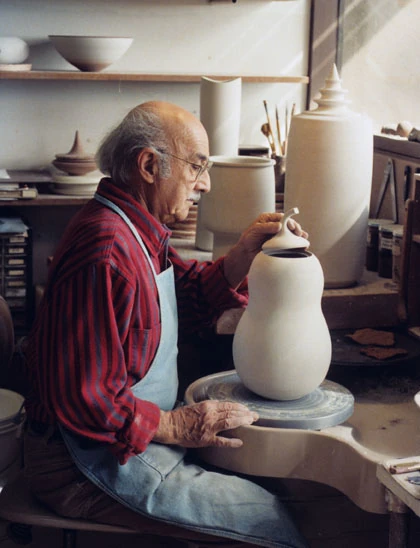
- Renwick Gallery, Smithsonian Museum, Washington, D.C.
- Musée des Arts Décoratifs, Paris, France
- The National Museum of Art, Tokyo, Japan
- Museum of Fine Arts, Boston, Massachusetts
- Mingei International Museum, San Diego, California
- Los Angeles County Museum of Art, Los Angeles, California
- The Huntington Library, San Marino, California
- American Museum of Ceramic Art, Pomona, California
- 1988 Elected Fellow of The American Craft Council, New York, NY
- 1999 Oral History, National Archives of American Art, Smithsonian Institution, Washington, D.C.
Harrison McIntosh Video
- The Ceramic Art of Harrison McIntosh: A Personal View of the Artist. McIntosh Productions, 1994.
- Video Interview of Harrison McIntosh. Los Angeles Museum of Contemporary Art, 2012.
- Harrison McIntosh Exhibit at AMOCA. KCET SoCal Connected, 2014.





